The 9.7" iPad Pro Review
by Brandon Chester on June 1, 2016 9:00 AM ESTDisplay Analysis
The 9.7" iPad Pro has what is by far the most interesting display I've seen on a tablet since the iPad 3, which was the first of the Retina displays. Samsung is arguably the only other vendor making advances with tablet displays, since they're the only company that ships a calibrated AMOLED. However, Samsung has been limited with the brightness they can push on the larger AMOLED displays, and at the end of the day when you set to sRGB the only advantage is the black level when there's not much ambient light to wash the display out.
With the iPad Pro Apple has improved upon the anti-reflective coating that they introduced with the iPad Air 2, and they've moved to a wider color gamut while also implementing a dynamic color feature called True Tone. I'll be talking about True Tone on the next page, but for now I'll be running 9.7" iPad Pro through our standard display workflow, along with an additional test to examine the accuracy within the DCI-P3 color gamut.
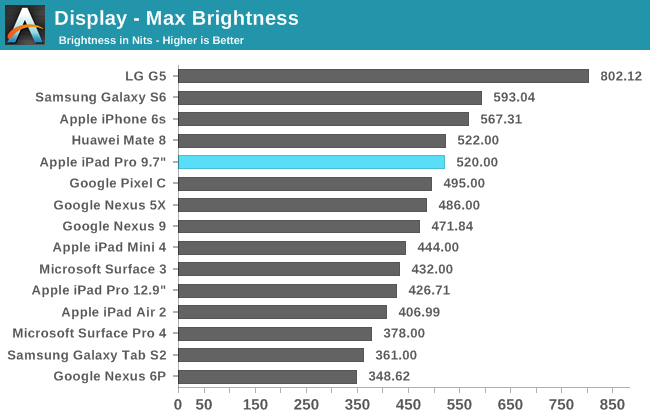
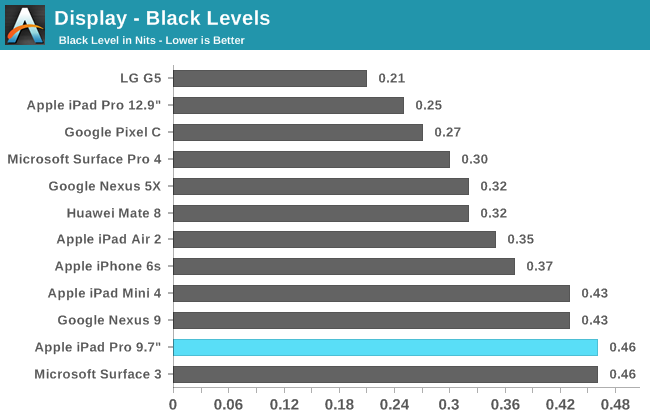
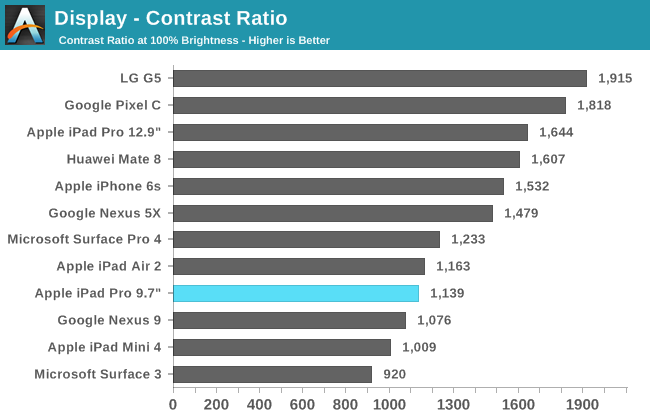
There are two things that I find surprising in the charts above. The first is that Apple actually exceeded their advertised 500 nit brightness. This puts it at the top of our brightness list for tablets, and that's no small feat. Apple's new backlighting array has enabled both a significantly wider gamut and a much higher brightness. Combined with their new anti-reflective coating, the 9.7" iPad Pro handily beats the larger model and the iPad Air 2 as the most usable tablet in bright ambient lighting.
While the 9.7" iPad Pro is quite bright, it doesn't do so well with black levels. Compared to the Pixel C, which has only a slightly lower brightness, the 9.7" iPad Pro's black level is much higher, and the contrast ratio is significantly lower as a result. It's also lower than Apple's 12.9" iPad Pro, and I verified Josh's brightness and black results for the 12.9" iPad against my own to confirm that he didn't just get an exceptional sample. I'm honestly a bit surprised that the gap between the two is so large, as the 9.7" iPad Pro's display is more advanced than the display of the larger model in several respects.
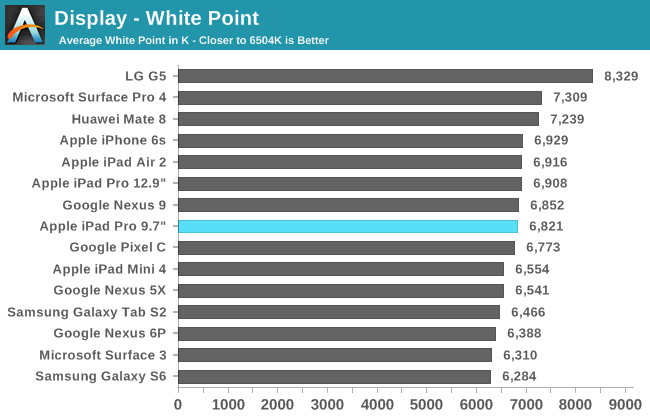

The 9.7" iPad Pro has great greyscale accuracy. Like most of Apple's products, there is a degree of blue shifting, but it's not quite as heavy as on their other products. The gamma is quite straight, and no shade of grey has a DeltaE that hits three, which is generally the goal. The accuracy isn't as high as the iPad Mini 4 which exhibited a surprisingly high degree of accuracy, but beyond the slight blue shift there's not really anything to complain about here.
DCI-P3 Gamut Saturation Sweep
The iPad Pro is Apple's second device that has moved to a wide color gamut. The first was the 2015 iMac with Retina 5K display, and from it we learned a number of things about Apple's implementation. The first thing to make note of is that the display conforms to the DCI-P3 gamut, but it doesn't use the corresponding 2.6 gamma that goes along with the standard. Using that gamma would be a mistake because no content coming on UltraHD Blu-ray is going to use that gamma function, so it's not really an issue in practice. While it remains to be seen how Apple's wide gamut devices will handle content that uses the SMPTE 2084 EOTF, Apple has brought color management to iOS and can transform content that uses a different gamma curve than the 2.2 gamma that the display targets.
Because Apple has implemented color management, they're able to accurately render anything designed for color spaces that sit within the DCI-P3 color space, with the most relevant one being sRGB. For devices with wide color gamuts and color management we'll be testing them against their target gamut and the sRGB gamut for our saturation tests. First up is the DCI-P3 saturation sweep, which uses 20% steps like our sRGB test but obviously targets the wider DCI-P3 gamut and uses Apple's target gamma of 2.2.
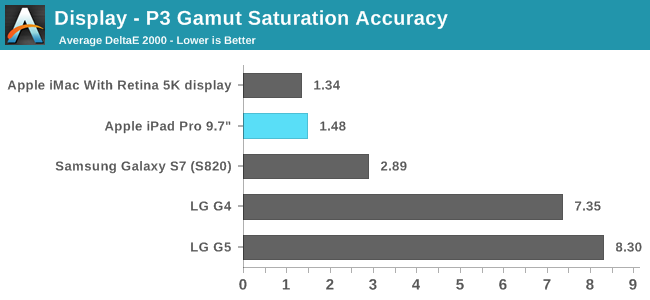
Because only a small group of devices claim to support this color gamut, I don't have as many points of comparison as we usually do. To be honest, the few that we have make it clear that Apple is currently without competition here. The other vendor actively advertising DCI-P3 gamut support is LG, and we've seen that the LG G4 and G5 do not even come close to actually meeting this goal regardless of which gamma target you use. In fact, they're bad enough that Samsung's accurate Adobe RGB mode on the Galaxy S7 accidentally beats them for P3 accuracy here, as it ends up being accurate in areas where the gamuts are very similar and only really has errors along red and with some deep saturations of colors that rely on red or blue.
As for Apple, they're the only vendor that actually covers the red-dependent segment of the gamut and their DeltaE values are incredibly low. The only issue I can see is that green is a bit inaccurate, which seems to be due to the display's blue shift. This is really me looking for criticism though, and with a DeltaE average of 1.48 the only device that beats it is a $2000 iMac.
sRGB Gamut Saturation Sweep
Because each 9.7" iPad Pro is individually calibrated, the color profile included is essentially a perfect description of the physical display's characteristics and color output. Because of this, the profile can be used to map colors from the sRGB color space to the display's native gamut with a high degree of precision, which is only limited by the display's color depth. In fact, this potentially allows for greater accuracy than if the display had been calibrated against the sRGB gamut in the first place, as the small error levels in Apple's calibration are accounted for by the profile and when doing color transformations.
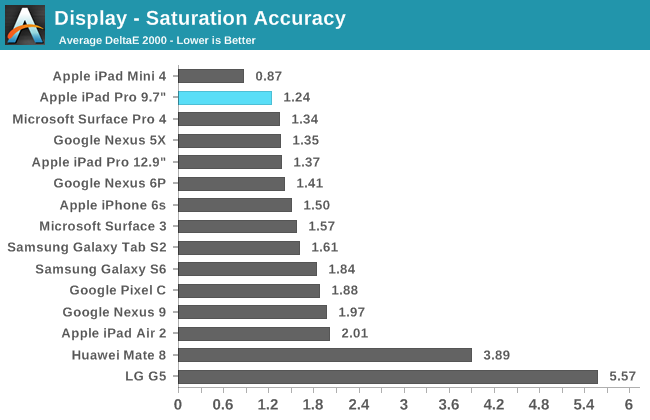
When displaying content designed for the sRGB gamut, the 9.7" iPad Pro is incredibly accurate. It's actually more accurate than the already near-perfect P3 results, with the red, blue, and green primaries being even closer to their target values. The only color that ever has an error above two is 20% saturated yellow, and the largest error is actually white which as we saw earlier is a bit too blue. Aside from those, every color has a DeltaE below two, and many are around or even below one. There's honestly not much more Apple could do here; this really is a professional-grade display.

As one would expect, the 9.7" iPad Pro has no trouble rendering the color mixtures from the GretagMacbeth ColorChecker test. The largest errors are actually the greyscale shades, and none of the DeltaE values for colors actually go above two. It's worth noting that the colors in this test are defined such that they should always be the same regardless of the color space, and so the fact that I've targeted sRGB has no change on the test outcome. For reference, changing the target to the P3 gamut produced an average DeltaE of 1.56, and I did that test at a later time so the error is well within the bounds of errors relating to the position of the meter on the display and the small inherent measurement error of the i1Pro 2 itself. This is a good example of Apple's color management at work, as my untagged image files were correctly inferred as having been created with the sRGB color space in mind, and transformed into the display's native gamut.
As far as tablet displays go, the 9.7" iPad Pro has the best one that I've seen. The combination of greatly improved peak brightness, extremely good color accuracy, an improved anti-reflective coating, and support for a wider color gamut all contribute to this, and the usefulness of aspects like the wide gamut will become even more apparent as time goes on and more content supporting it is released.



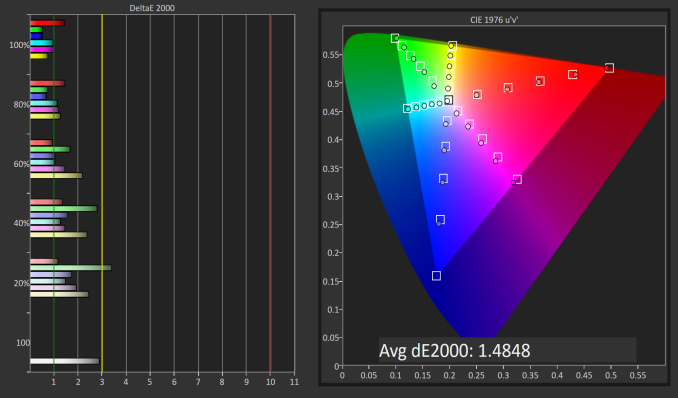
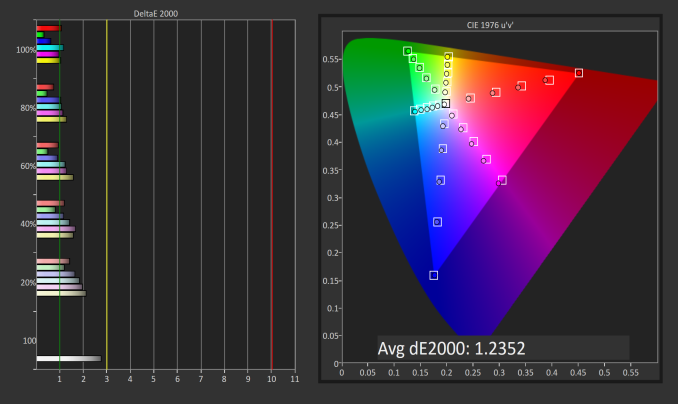
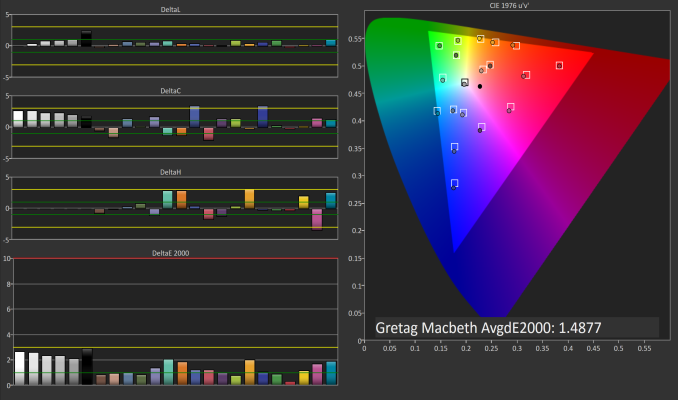








144 Comments
View All Comments
digiguy - Friday, June 3, 2016 - link
What do you know? even core I7 has been made fanless in a 12 inch tablet with a new cooling solution, so I don't see why core M could not work well in 10 inches. Battery life will depend on the battery size, in the onda it's smaller than in ipad air 2 for instance, and it lasts around 4 hours, with a bigger one it could last more, but is definitely much more than the 1 hour you speculate about...erple2 - Sunday, June 5, 2016 - link
But then that's the point, isn't it? Throwing a honestly poorly designed 10" tablet as proof that you can get a good tavlet with Core M is not helping your argument. How good is the display? How are the touch apps? How well does the pen work? How heavy is it? How hot does it run? How long does it run on a charge? What about everything else that is tested? Honestly, there has to be a reason why the big players hasn't integrated a more powerful CPU into a small tablet.As a staunchly anti Apple person, I gave to co cede that Apple really does have the best tablet this generation. While the Pixel C comes close, the Pen is very well implemented. Surfaces are fine, but I find that when I want to do real work, I turn to my much more powerful laptop to do that.
melgross - Wednesday, June 1, 2016 - link
Neither Surface Pro display can match the display for this product. First of all those products were reviewed before this one came out, and secondly, they are both sRGB displays, with their resultant smaller color gamut.Also, the iPad Pro, either model beats the least expensive Surface Pro in performance, and that model costs as much, or more than the competing iPad.
I understand that your Microsoft products are second best in a number of ways. Get used to it.
jlabelle2 - Thursday, June 2, 2016 - link
Having a wider color gamut than sRGB is not universally an advantage. Without going into this discussion on how many (little) images are benefiting from that, even in a proper color managed workflow (and iOS seems to be quite good here), sharing and distributing images with wider color space than sRGB is often (most of the time) counterproductive if others 1/ do not have wide gamut screen (the majority), 2/ do not have applications / browser reading the embedded color space (the majority). As such, the interest is honestly quite limited. It does not hurt at all the iPad, on the contrary, but in real life this is not what will make such display stands above other sRGB gamut wide screens.And regarding the Surfaces and DisplayMate, read in details and you will see they are also praised equally :
"The Surface Pro 4 also has the most accurate on-screen colors of any Tablet display that we have ever measured"
"However, Microsoft has also taken an important initial step, with the Surface 3 providing its best Color Accuracy in typical indoor 300 lux ambient"
My point is that many tablets have just excellent screens and that the iPad Pro does not seem to stand in a class of its own at all. But what makes Surfaces screens a real treat for people that value color accuracy is being able to calibrate the screen. That is making all the difference.
Because LCD screen colors evolve unfortunately with time. It would be interesting that Brandon would test and iPad Air 2, today, used since the beginning and how it differs of the original out of the box measurement.
As such, if we are taking only this criteria, for designer or photo / video editor that value utmostly color accuracy, the non calibrating iPad display is a drawback. I mentioned this because making some photo editing on the wedding I shoot, I can clearly see that the iPad Air 2 I have is no match with the Surface Pro 3 I also have, once calibrated.
Meteor2 - Thursday, June 2, 2016 - link
Cor, you're angry.grayson_carr - Thursday, June 2, 2016 - link
You can compare the displays at the link below. Basically, the calibrations are on par out of the box, with the iPad having a slightly better calibrated white point. The iPad has MUCH higher max brightness and a higher color gamut. The Surface Pro 4 has slightly better contrast and like you said, the ability to do your own calibration. Out of the box I would say the iPad Pro has the slight edge with the higher brightness, higher color gamut, and true tone feature. But the Surface Pro 4 display might be better for professionals down the road with the ability to recalibrate it.http://www.anandtech.com/bench/product/1697?vs=157...
nikon133 - Thursday, June 2, 2016 - link
Performance... in what scenarios? Only if there are pro apps to take advantage of that power, does performance have any meaning. Right now, iPad Pro's "power" is only good for rubbing it into others' faces over a cup of coffee. Once these babies are put to use, iPP turns out just faster iPad, but far cry from Pro device. In real life, it is just an iPad that will turn iBook pages faster, do smoother fly-overs in Apple Maps. Have Apple decided to call it iPad Air 3, no-one would know the difference.I'm finding it ironical that, for ecosystem (and fans) insisting on quality and quantity of casual apps in library, suddenly lack of apps in Pro segment is being ignored or played down. One can't do much on it, but look, oooh, it is so fast.
iPad Pro can be twice as fast as i7 Surface... but without tools from Adobe, Corel, Audodesk... even full-blown Office suite... how is it better Pro tablet than any x86 device?
Re pricing. I cannot compare 32GB iPP with 128GB SP. Much as prices go here in NZ - might differ where you are - 128GB 9.7" iPP is NZ$1,329.00, plus NZ$189 for pen. That makes NZ$1,518, compared to $1,439 for 128GB mCore SP4, which comes with pen. Even if we ignore that these are prices from Apple's and MS's web stores and that SP can be found even cheaper in shops, while iPP basically can't... even if we stick to these prices... you are saying that more expensive device with smaller screen, crippled multitasking, no real library of pro software, no easy (or any, in some cases) way to dock it, connect it to multiple desktop screens, wired network, USB devices... is somehow better device just because it cranked out better score in some synthetic benchmarks..?
OK...
Lochheart - Friday, June 3, 2016 - link
Yes, the Surface can run Adobe, Corel, Autodesk... etc...Do you think anyone will buy a Surface when it need to work on Adobe tools ? It will never happen.
Who work on a 12" screen ? My 15" Laptop is already to small... So yes, a Surface can run lot of stuff... but compare to what we have on PC side, it's just a outdated config overhype.
jlabelle2 - Tuesday, June 14, 2016 - link
"Do you think anyone will buy a Surface when it need to work on Adobe tools ? It will never happen."I do. This is why I replaced my iPad (my wife is still using her iPad Air 2 for casual stuff) with a SP3 and gave my desktop to my kids. I am using the SP3 as a tablet in the bed, train, airplane for media consumption and tablet things, I am attaching the keyboard when I want to type things, but I can also develop my RAW files in the train with Capture One Pro (alternative from Adobe Lightroom) or in the bed in tablet mode. And 12" is plenty enough to work on pictures as the screen is high resolution and you can easily pinch to zoom.
Or I can simply dock it and use it with a calibrated 27" monitor / keyboard and mouse. That is THE point of using a Surface. Doing more than an iPad.
"but compare to what we have on PC side"
It IS a PC. Also. It replaces basically the need for a PC for 98% of the people.
mrochester - Wednesday, June 1, 2016 - link
I see you post in a similar vain here as you do on the Verge forums!